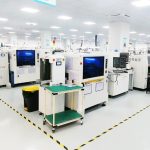What tests does PCBA mainly include?
PCBA test refers to the test of IC burning, circuit on-off, current, voltage, pressure, etc. of PCBA board. There are many uncontrollable factors in the production process of PCBA, which makes it difficult to ensure that PCBA is a complete product. PCBA testing is a necessary link to strictly control the quality of shipments. Next, we will introduce the main process of PCBA test.
1.Which tests are mainly included in PCBA test
PCBA testing varies according to different products and different customer requirements. In general, PCBA testing mainly includes ICT online testing, FCT function testing, and aging testing.
2.PCBA test process
PCBA testing generally develops a specific testing process according to the customer’s testing plan. The basic PCBA testing process is as follows:
Program burning → ICT test → FCT test → aging test.
After the welding process of the front end of the PCBA board is completed, engineers begin to burn the program of the microcontroller in the PCBA board, so that the microcontroller can achieve specific functions.
ICT test is mainly used to test the open circuit and short circuit of PCBA circuit and the welding of electronic components by contacting the test point of PCBA with the test probe. ICT test has high accuracy, clear instructions and wide range of use.
FCT test can test the environment, current, voltage, pressure and other parameters of PCBA. The test content is relatively comprehensive, which can ensure that various parameters of PCBA board meet the design requirements of the designer.
Aging test.
The aging test can ensure the stability of the product by continuously energizing the PCBA board, simulating the user’s use scenario, detecting some defects that are difficult to find, and checking the service life of the product.
After a series of PCBA tests, PCBA boards without problems can be labeled as qualified, and then packaged for shipment.
3.Simple processing flow of PCBA:
PCBA processing single-sided surface assembly process: solder paste printing patch reflow soldering;
PCBA processing double-sided surface assembly process: A-side printing solder paste patch reflow soldering flap B-side printing solder paste patch reflow soldering;
PCBA processing single side mixed packaging (SMD and THC are on the same side): solder paste printing – patch – reflow welding – manual plug-in (THC) – wave soldering;
Single side mixed packaging (SMD and THC are respectively on both sides of PCB): red glue printed on side B – patch – red glue curing – flip plate – side A plug-in – wave soldering on side B;
Double side mixing device (THC is on side A, and SMD is on both sides of A and B): A-side printing solder paste – patch – reflow welding – flip plate – B-side printing red glue – patch – red glue curing – flip plate – A-side plug-in – B-side wave soldering;
Double side mixed packaging (SMD and THC are available on both sides of A and B): A-side printing solder paste – patch – reflow welding – flip plate – B-side printing red glue – patch – red glue curing – flip plate – A-side plug-in – B-side wave soldering – B-side plug-in is attached behind.
In the soldering process, the smallest variables should belong to machines and equipment. Therefore, they should be checked first. In order to achieve the correctness of the inspection, independent electronic instruments can be used for assistance, such as measuring various temperatures with a thermometer and accurately correcting machine parameters with an electric meter.
PCBA is to process a blank PCB through a series of processes, and finally process it into an electronic product that can be used by users. In the process of production, each link is linked to the other. Any quality problem in any link will have a great impact on the quality of the product.


